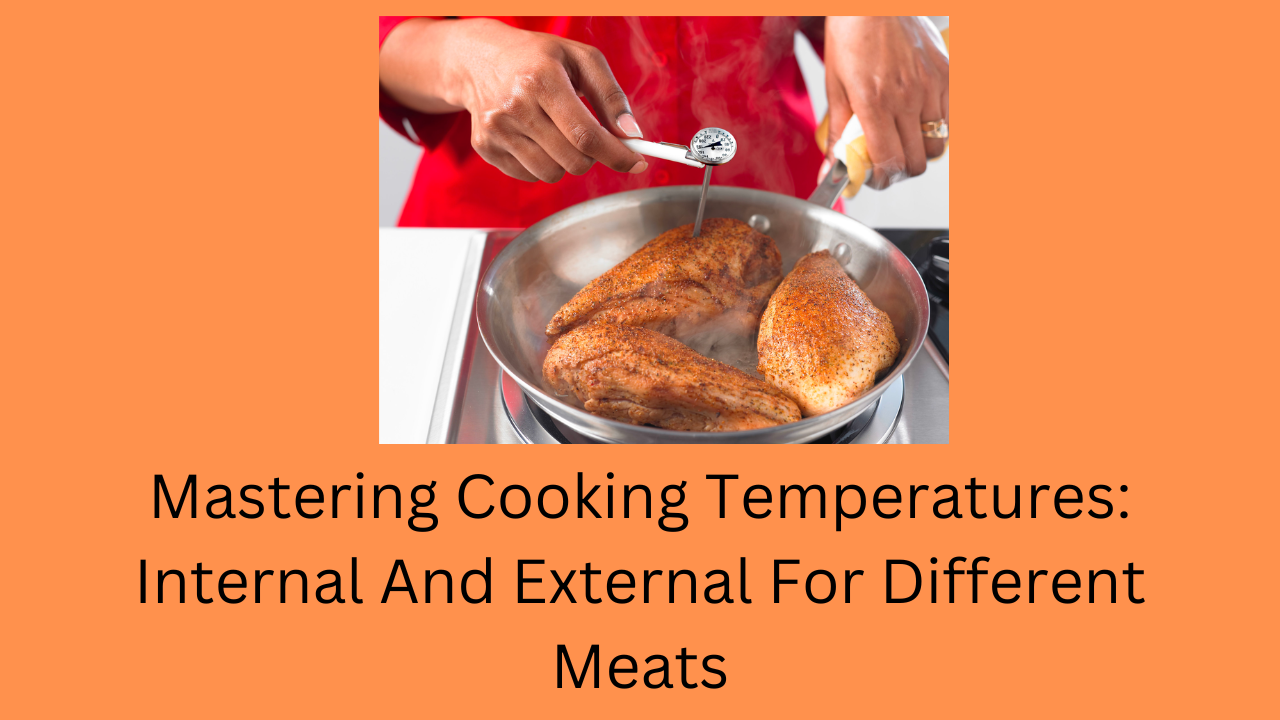Mastering cooking temperatures: internal and external for different meats- Ever stared at a sizzling steak with apprehension, unsure if it’s safely cooked through? Or maybe you’ve bitten into a chicken breast only to find it disappointingly pink and undercooked. Navigating the world of meat temperatures can be a minefield, filled with fear of food poisoning and the dreaded dryness of overcooked protein. But worry not, culinary adventurers! This blog is your passport to mastery of internal and external cooking temperatures for different meats.
We’ll demystify the science, equip you with essential knowledge, and empower you to cook meat with confidence,ensuring juicy results and foodborne illness-free feasts. So, grab your thermometer, ditch the guesswork, and get ready to unlock a world of perfectly cooked protein perfection.
What’s Cooking Temperature
In the context of food safety and culinary practices, cooking temperature refers to the internal temperature reached by the thickest part of your food item during the cooking process. This is crucial for ensuring the food is cooked through and safe to eat, as different bacteria and parasites are deactivated at specific temperatures.
However, cooking temperature also encompasses the external temperature, especially when considering factors like browning, caramelization, and achieving a desired sear on meats. Here’s a breakdown of both aspects:
1. Internal Cooking Temperature:
- This is the critical temperature reached inside the food, measured with a food thermometer.
- Different types of food have specific minimum internal temperatures recommended by food safety authorities to ensure the destruction of harmful pathogens.
- For example, ground meat requires a higher internal temperature (e.g., 160°F) compared to whole muscle meats like steak (e.g., 145°F for medium-rare).
- Reaching the correct internal temperature throughout the food is essential for food safety, regardless of the chosen cooking method.
2. External Cooking Temperature:
- This refers to the temperature at the surface of the food during cooking.
- It impacts factors like browning, caramelization, and achieving a desired sear, particularly for meats.
- For example, searing a steak at a high temperature creates a flavorful crust while leaving the interior juicy.
- Cooking method and desired outcome influence the ideal external temperature.
In essence, cooking temperature involves both the internal and external temperatures of your food. Understanding and controlling both aspects ensures safe and delicious culinary results.
Why Do Different Meats Have Different Cooking Temperatures?
The internal temperature at which various meats are considered safe to eat differs for several reasons:
1. Varying Susceptibility to Bacteria:
Different types of meat harbor different bacteria and parasites. Ground meats, due to their processing, have bacteria distributed throughout, requiring a higher internal temperature (e.g., 160°F for ground beef) to ensure all harmful pathogens are eliminated. In contrast, whole muscle meats like steaks only have bacteria on the surface, allowing for lower safe temperatures (e.g., 145°F for medium-rare steak) as long as the internal temperature reaches that level throughout.
2. Texture and Doneness Preferences:
Cooking temperature directly impacts the texture and doneness of meat. Higher temperatures result in firmer, drier textures, while lower temperatures yield juicer, more tender results. Different cuts and meats have preferred doneness levels due to their inherent characteristics. For example, brisket benefits from slow cooking at lower temperatures to break down tough collagen, while a quick sear is ideal for maintaining the delicate texture of scallops.
3. Fat Content and Cooking Methods:
Fatty meats like pork belly can handle higher temperatures without drying out excessively due to their internal fat content.Similarly, cooking methods like braising or stewing rely on lower temperatures over longer periods to tenderize tougher cuts. Understanding the interplay between fat content, cooking method, and temperature allows for optimal results that balance safety and desired texture.
4. Cultural and Regional Preferences:
Different cultures and regions have varying preferences for how they like their meat cooked. In some cuisines, raw or lightly cooked options are enjoyed, while others favor well-done meat. However, it’s crucial to prioritize food safety and adhere to minimum internal temperatures recommended by authorities to avoid potential health risks.
5. Personal Taste:
Ultimately, your desired level of doneness plays a role in selecting a cooking temperature. Experimenting within safe ranges and exploring different cooking methods allows you to discover your individual preference for the texture and flavor of various meats.
By understanding these factors, you can confidently navigate the world of meat temperatures, ensuring food safety while achieving the perfect texture and flavor profile for your culinary creations.
Mastering Cooking Temperatures: Internal And External for Different Meats
Cooking meat can be intimidating.expand_more Balancing safety with desired doneness and achieving juicy perfection feels like navigating a culinary maze. But fear not, carnivores! This guide delves into the secrets of mastering internal and external cooking temperatures for different meats, transforming you from cooking novice to confident grill master.
First things first:
- Food safety is paramount. Always utilize a food thermometer to measure internal temperature, ensuring it reaches the minimum safe level for that specific meat. This eliminates harmful bacteria and prevents foodborne illness.expand_more
- Doneness levels vary: From the blushing pink of a “rare” steak to the well-done comfort of pulled pork, understanding your preferred doneness is crucial. Different cuts and meats have ideal doneness ranges based on texture and flavor preferences.expand_more
Now, let’s explore the internal temperature terrain:
- Ground Meat: Due to its dispersed bacteria, ground beef and similar products require a higher internal temperature (e.g., 160°F) to guarantee safety.expand_more No pink allowed!
- Whole Muscle Meats: Steaks, chops, and roasts harbor bacteria on the surface.expand_more Once the internal temperature reaches the safe minimum (e.g., 145°F for medium-rare steak), sear the surface for browning and flavor without compromising safety.
- Poultry: Chicken, turkey, and duck demand internal temperatures of 165°F, ensuring no trace of pink remains.expand_more Remember, poultry can harbor harmful bacteria throughout, not just on the surface.
Next, let’s delve into the external temperature arena:
- The Sear: High external temperatures create a delicious, caramelized crust on steaks, chops, and other meats.expand_more Experiment with searing techniques like grilling or pan-frying to achieve your desired level of browning.
- Slow and Steady Wins the Race: Roasts and braises benefit from lower external temperatures over longer periods. This gently renders collagen, resulting in fall-off-the-bone tenderness without compromising safety.
Important Considerations
- Resting is key: Allow cooked meats to rest after reaching their internal temperature.expand_more This allows juices to redistribute, ensuring a more flavorful and succulent final product.expand_more
- Invest in a good thermometer: An accurate thermometer is your weapon of choice in this culinary battle. Use it regularly and confidently.
- Experiment and explore: Once you master the basics, experiment with different cooking methods, marinades, and spices to create unique and flavorful meat masterpieces.
By understanding both internal and external cooking temperatures, you’ll navigate the meat maze with confidence, ensuring delectable and safe dishes that wow your guests and leave you feeling like a culinary champion. So, sharpen your knives, fire up your grill, and get ready to conquer the world of meat temperatures! Remember, the perfect bite of juicy, flavorful meat awaits!
Conclusion
So, ditch the fear and embrace the flavor! Mastering internal and external cooking temperatures for different meats isn’t a magic trick, it’s an achievable skill waiting to be unlocked. Armed with this knowledge, you’ll transform from grill rookie to meat maestro, leaving burnt offerings and undercooked woes in the dust. Remember, food safety is the foundation, but exploration and personal preference pave the way to culinary nirvana.
So, grab your thermometer, experiment with confidence, and embark on a delicious journey of mastering the meat maze. Your taste buds will thank you, and your culinary prowess will shine bright. ENJOY YOUR MEAL.

